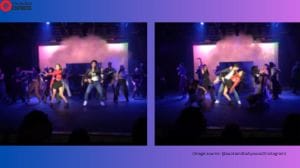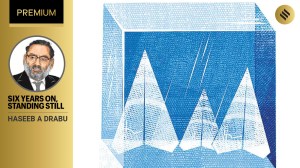Battling 107°F fever with ice and water: Inside RML Hospital’s heat stroke unit
This specialised unit for heat stroke patients was, in fact, launched at RML hospital on May 8 as the temperatures started soaring in Delhi.
 (Left) Immersion tubs inside the unit; (Right) the hospital also has an inflatable tub to be used in emergency. (Express File Photo)
(Left) Immersion tubs inside the unit; (Right) the hospital also has an inflatable tub to be used in emergency. (Express File Photo)Daily-wage worker Raju Kumar is lying on a bed, connected to a ventilator. The 35-year-old migrant worker from Jhansi breaks stones at a road construction site in Mahipalpur. He has had a heat stroke and after several hours in the critical care unit, doctors are finally hopeful he may make it.
It is around 2 pm on Tuesday and a large number of patients have lined up outside the Emergency of Ram Manohar Lohia (RML) Hospital near Rashtrapati Bhavan, waiting. A group of 10 doctors are busy triaging patients, based on their condition. The hospital has divided its emergency response into three sections: the ‘Red Zone’ is exclusively for critical patients, the ‘Yellow Zone’ is for patients who are out of danger, and the ‘Green Zone’ is for people with minor injuries.
Raju was put in the ‘Red Zone’ as soon as he arrived in the morning. Doctors immediately diagnosed him as having suffered a severe heat stroke. “He works as a daily wage labourer,” 30-year-old Anjana Kumari, his wife says. “He was working all day on Monday and was fine when he returned home around 7-7.30 pm.”
The couple lives in a jhuggi in Mahipalpur. “We have a fan in our jhuggi which wasn’t working. My husband went to sleep but soon, there was a power cut in our entire area. It was suffocating inside our home. Raju woke up and went out to sleep in the open. But he couldn’t sleep and after a few hours, he started feeling uneasy,” she recalls.
Anjana brought him to the RML Hospital around 10 am. Once admitted to the emergency, his body temperature was more than 107 degrees Fahrenheit – which is unprecedented. This was his rectal temperature, say doctors, which is measured using a special instrument after inserting it in a person’s rectum. The rectum is near the body’s core, where internal organs are located which is why it is the most accurate way of measuring a person’s temperature.
Raju also had seizures. “He was vomiting and also had uncontrolled diarrhoea. He didn’t sweat though,” she says. Doctors immediately moved him to the heat stroke unit where he was put in a bathtub filled with ice and cold water to regulate his body temperature.
This specialised unit for heat stroke patients was, in fact, launched at RML hospital on May 8 as the temperatures started soaring in Delhi. Two bathtubs, an ice maker and two ventilator beds were included in this unit. One of the ventilator beds also has an inflatable tub in case more than two heat stroke patients require an immersion procedure to lower their body temperature.
Till now, around 20-25 patients have been admitted to the unit.
Anjana recalls that doctors kept her husband in the tub for around half an hour before he was shifted to the ‘Red Zone’. “Doctors said he will take time to heal. They told me he won’t be able to walk for some time and will need a lot of care,” she says.
Doctors say Raju arrived at the hospital very late, 12 hours or more after the heat stroke.
Head of Emergency Medicine at RML hospital, Dr Seema Balkrishna Wasnik, says heat stroke patients coming in late makes their management a big challenge. “They do not understand the symptoms and don’t rush to the hospital,” she says. “Considering the soaring temperatures, the treatment requires that the patient must be immersed in ice and cold water immediately.”
On Tuesday, the heat stroke unit saw four patients who were later put on a ventilator in the Intensive Care Unit. In the ‘Yellow Zone’, 36 patients were suffering from high fever after heat-related illnesses. Seven patients with heat stroke were admitted to the Emergency Cardiac and Stroke System of the RML hospital.
‘First-such facility in North India’
Wasnik says the RML’s heat stroke unit is the first such exclusive facility in North India and was specially launched to look after patients of heat-related illness. “We had anticipated that because of the rising temperatures, we may face an emergency situation,” she says.
Wasnik says a lot of such patients reach the hospital in critical condition. “They are mostly from poor backgrounds exposed to heat, many are those going on pilgrimages, others are security guards, ragpickers, those living on top floors of the house,” she explains.
“… When they arrive (at the hospital), they have symptoms like seizures, are unconscious, the heart is not functioning properly, pulse rate is irregular, are severely dehydrated, and have an electrolyte imbalance”
She says in the unit, the hospital’s specialists use the immersion procedure to lower body temperatures of patients. “When we immerse these patients in a bathtub filled with ice, we have to keep their faces out because most of them are already unconscious. This procedure helps bring down the body temperature to 102 Fahrenheit within 20-30 minutes,” she says. “The routine procedure of giving paracetamol injections doesn’t work in such patients.
She says they are seeing patients aged between 20 and 80 years. “… majority of them are between 60 and 65 years with co-morbidities,” she says.
Meanwhile, Raju is still unconscious. His wife was silently weeping while sitting on a chair right outside the ‘Red Zone’. “Will he be cured?” she keeps asking.












